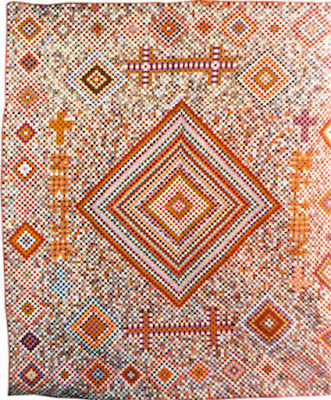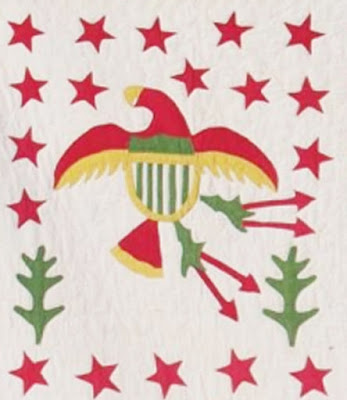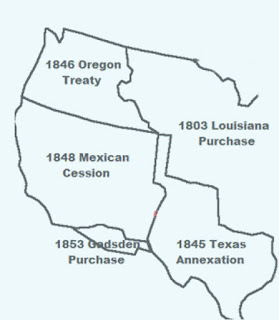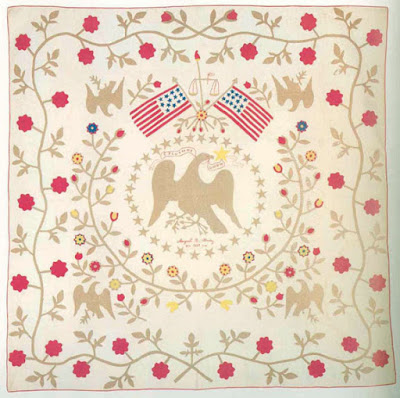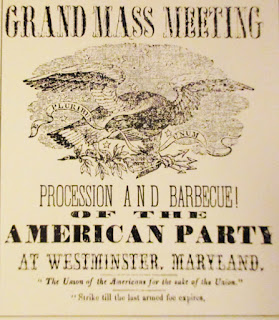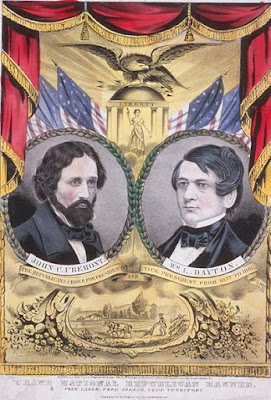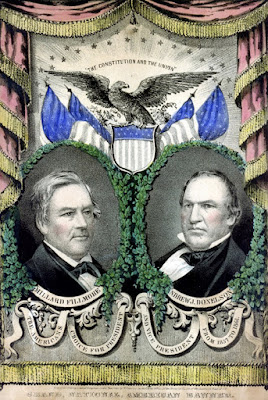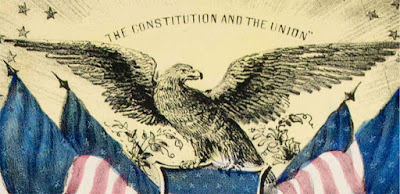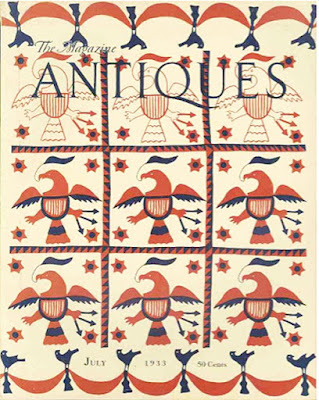Years ago I was knocked out by this crib quilt on
a visit to Colonial Williamsburg.
Tulip Cross Crib Quilt 45-1/2" x 35-1/2"
Member of the Richter Family, Ripley County, Indiana.
Possibly Anna Richter in Sunman, Indiana
A few months ago I saw another version of the same pattern in Julie Silber's stack of antique quilts for sale at the American Quilt Study Group in New Hampshire.
I took a picture and when I went back to look at the whole
thing it was gone. Sold to a happy collector.
I have photos of several quilts in the same pattern in a file.
Here it is as a center medallion in a quilt documented
by the Indiana project, seen in Terre Haute. They thought it might
be 1850. From the picture with it's strong green and feather quilting
this seems possible.
I thought this quilt in Mary Koval's booth was the same
one but it's not. Similar corners and a border, but this
one's more delicate and missing some parts.
I mention the strong greens because several versions like this one sold at Cowan's Auctions were stitched with the fugitive greens so common after 1880. Those leaves and stems were probably once a dark green with a touch of blue but the early synthetic dyes faded badly. So I am guessing this one is after 1880.
From an online antique dealer
Same arrangement of the same blocks. It's not
the same quilt though. The green has faded more gray than brown in
this one.
Coxcomb
International Quilt Study Center & Museum
#2007.038.010
Yet another example, same fading problem with the
greens (Turkey reds and double pinks are far faster.)
Fading to tan where it was folded and exposed to light.
The one above, fortunately, is dated: 1885
but that's all they know.
This one from an eBay auction has faded so
badly that the green is barely visible
The pale scallop on the left was once dark green I bet.
So what we have here is a regional pattern that seems to have been passed around from
1850 to about 1900. It was often the center of a nine-block applique quilt of three different designs. I'd guess that region was Indiana.
Ripley County is near the Ohio River
west of the state of Ohio.
Coxcomb with Birds
84" x 84", 1995
Look how nice the green is on this one. That's because it's
a recently done reproduction.
Anita Shackelford made it for her book
Coxcomb Variations.
I imagine you can find a pattern here
and make one of your own.
Anita owns the antique quilt she used for inspiration.
See the crib quilt at Colonial Williamsburg here:
The caption gives us a good deal of information.
"According to Don Walters, the dealer who sold the quilt, the quilt can be attributed to Alma Richter. Another quilt in a similar pattern (in a private collection in the 1980s) was also said to be made by Alma Richter in 1854. A search of Ripley County, Indiana, records failed to locate an Alma Richter around that date. However, one Alma Richter, 1898-1984, had a German-born Grandmother who lived with her family in Ripley County, Indiana. The Grandmother Anna Richter was a widow who was born in Germany in 1814 and immigrated to the United States in 1841. Anna Richter may be the real maker of the quilt. It appears that the woman whose estate was sold in 1985, Alma, may have been mistakenly credited with making the quilt. It is unclear where the 1854 date came from."



































































































